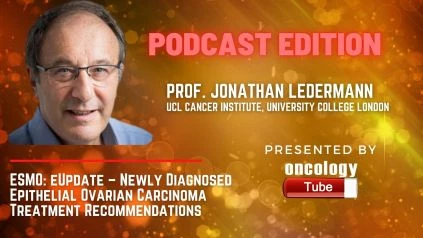Prof. Jonathan Ledermann from the UCL Cancer Institute, University College London speaks about eUpdate – Newly Diagnosed Epithelial Ovarian Carcinoma Treatment Recommendations.
Maintenance therapy with the poly-adenosine diphosphate (ADP)-ribose polymerase (PARP) inhibitors olaparib or niraparib after surgery and chemotaxis was investigated in three phase III trials (SOLO-1, PAOLA-1/ENGOT-ov25, and PRIMA/ENGOT-OV26) in newly diagnosed high-grade epithelial ovarian cancers (including fallopian tube and peritoneal) (PFS).
SOLO1 looked at first-line maintenance monotherapy with olaparib for two years in women with FIGO stage III-IV ovarian cancer and a BRCA mutation who had a partial or complete response to platinum-based ChT.2 The primary findings showed that maintenance with olaparib reduced the risk of disease progression by 70%. (HR 0.33, 95 percent CI 0.25-0.43). Both the European Medicines Agency (EMA) and the Food and Drug Administration (FDA) have authorized olaparib as maintenance treatment in BRCA-mutated patients in initial remission after platinum-based therapy after 5 years.6
Patients with stage III-IV ovarian cancer and no residual disease after primary debulking surgery were excluded from PRIMA/ENGOT-OV26, which evaluated niraparib as maintenance therapy for up to 3 years in patients with a high risk of treatment failure, with or without BRCA mutation.3 Patients with stage III ovarian cancer and no residual disease after primary debulking surgery were excluded, and 67 percent of patients had received neoadjuvant ChT. The Myriad myChoice test was used to stratify patients based on the tumor’s homologous recombination repair deficit (HRD) (defined as an HRD score of 42 or higher). The HRD population was analyzed first, followed by the all-comer population in a hierarchical order. The HRD group (HR 0.43, 95 percent CI 0.31-0.59, P0.001) and the general population (HR 0.62, 95 percent CI 0.50-0.76, P0.001) both exhibited a substantial increase in PFS. An exploratory subgroup study revealed that women with a BRCA mutation benefited the most, whereas BRCA wild-type women with HRD benefited significantly but less. The median PFS in the HRD-negative, also known as homologous recombination proficient (HRP) group increased by 2.7 months (HR 0.68, 95 percent CI 0.49-0.94, P=0.020). Niraparib has been authorized by the European Medicines Agency (EMA) and the Food and Drug Administration (FDA) as a maintenance treatment for unselected patients in initial remission after platinum-based therapy.
Patients with stage III-IV ovarian cancer, with or without residual tumor after surgery, were treated with ChT and bevacizumab in the PAOLA-1/ENGOT-ov25 trial, and after ChT were randomly assigned to maintenance therapy with olaparib tablets or placebo for two years, as well as completing 15 months of bevacizumab in both arms of the trial.4 The tumor BRCA mutation status and response to first-line therapy were used to stratify the randomization to olaparib or placebo. The primary analysis in the all-comer intention-to-treat (ITT) population revealed a significant improvement in PFS in patients receiving olaparib and bevacizumab, with a median PFS of 22.1 months compared to 16.6 months in patients receiving placebo and bevacizumab (HR 0.59, 95 percent CI 0.49-0.72, P0.001). HRD-positive women (defined using the Myriad myChoice assay as an HRD score of 42 or higher) -including women with BRCA mutation (HR 0.33, 95 percent CI 0.25-0.45) and HRD-positive women with BRCA wild-type (HR 0.33, 95 percent CI 0.25-0.45) -had the greatest benefit (HR 0.31, 95 percent CI 0.20-0.47). (HR 0.43, 95 percent CI 0.28-0.66). The HRD-negative/unknown population showed no benefit.4 Olaparib has been authorized by the EMA and FDA as maintenance treatment in BRCA mutant and HRD patients in initial remission after platinum-based therapy in conjunction with bevacizumab.
In the VELIA/GOG-3005 trial, standard ChT was compared to veliparib given during ChT and then as maintenance for up to 2 years, or veliparib gave only with ChT.5 A hierarchical testing analysis revealed a 56 percent reduction in the risk of progression or death among patients with a BRCA mutation (HR 0.44, 95 percent CI 0.28-0.68, P0.001). In the ITT group, the median PFS was 23.5 months, while in the veliparib and control groups, it was 17.3 months. Veliparib has not been filed for regulatory clearance as a first-line treatment.
In the first-line setting, all trials have shown a benefit in median PFS for PARP inhibitor maintenance therapy, with the greatest effect seen in women with a BRCA mutation.2-6 However, it is unclear to what extent later use of PARP inhibitors in the placebo arm will affect overall survival (OS), emphasizing the importance of uncensored OS evaluation as the studies progress.
In women with a BRCA mutation, olaparib monotherapy maintenance after first-line treatment is approved. It is also approved in several countries in combination with bevacizumab in a larger group for HRD tumors (BRCA mutation or BRCA wild type). Niraparib has also been licensed as a single agent in several countries for women with stage III-IV ovarian cancer who have responded to first-line treatment, regardless of biomarker status. In most individuals, the side effects of oral PARP inhibitors are tolerable, although there is a small increase in uncommon significant adverse events such as Acute Myeloid Leukemia/Myelodysplasia. Long-term survival statistics are not yet available; this will help decision-making regarding whether subgroups of patients benefit more from PARP inhibitors as a first-line treatment or as a recurrence treatment.

